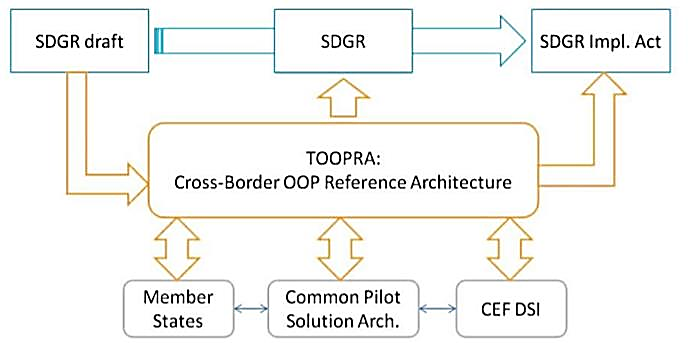1.
The Project ^
TOOP represents a large scale pilot project. The pilots are using an ICT system based on a federated IT architecture on a pan European scale. The aim of the project is to connect registries and eGovernment architectures to facilitate the exchange of data. The central ICT systems of TOOP interact with already existing systems in Member States and Associated Countries. Businesses will benefit from TOOP as they will be able to fulfil legal obligations with time- and cost-savings. The data provided to public administrations will always remain under full control and consent of the involved businesses, in accordance with EU data protection legislation. Administrations benefit from time and cost savings through the ICT support and will be able to offer higher service quality to businesses. The project’s research comprises the evaluation of the actual situation of OOP within Europe and also a research on the legal landscape.1
2.
Overview on Architectural Principle ^
The initial purpose of the OOP architecture is to fully support the development of specific information systems architectures supporting the Once-Only Principle. The TOOP project is in close relationship with the SDGR, to support the technical basis of the implementation of the regulation. This means that the architecture had to take into account new requirements emerging from SDGR.2 The TOOP reference architecture (TOOPRA) is developed by combining top-down and bottom-up approaches. First and foremost TOOP works within its legal environment and the specific user requirements from the «Member States» (i.e. pilots) as the guiding principles of the design of the architecture. This approach represents a blueprint for the TOOP systems and furthermore as an input for SDGR.

Depiction 1: TOOPRA approach3
The TOOPRA connects two different views, first the business related view (Business Architecture) and the ICT view (ICT Architecture) with the logical software and hardware capabilities that are required to support the IS architecture. The business architecture is first addressed from the information processing viewpoint.4 Out of this view the ICT specific architecture was developed.
3.
Overview on the Pilots ^
TOOP addresses three pilot areas within the large scale pilot approach:5
- Cross-border e-Services for Business Mobility
- Updating Connected Company Data
- Online Ship and Crew Certificates
The first pilot area «Cross-border e-Services for Business Mobility» comprises different business scenarios, for example the participation in public procurement procedures across borders, the support of doing cross-border business and cross-border service provision. The expected impact of all three use scenarios is not only at reducing the administrative burden for economic operators, but also at reducing operational costs of competent authorities and the time required for service provision.
The second pilot area «Updating Connected Company Data» tries to shift the burden of reporting changes of business data from the businesses to the business registers. Company data is already stored in the business register within individual Member States according to requirements of relevant EU regulations and directives as well as national legislation. Both ways are possible, first on demand in «pull» mode and second through a change notification service, by subscription, or in «push» mode.
The third pilot area, «Online Ship and Crew Certificates», addresses the need in the area of ship and crew certificates, which are currently issued and maintained in paper format and stored by national Maritime Administrations. This TOOP pilot tries at connecting the databases of national Maritime Authorities and to make the information available to authorised parties. Furthermore, TOOP will provide online certificates, which can substitute paper-based certificates that have to be carried with the ships.
- 1 Deliverables 2.5 on the legal landscape research, and D2.6, D2.7 and D2.14 on the evaluation on OOP in Europe (http://www.toop.eu/deliverables).
- 2 On SDGR: https://ec.europa.eu/info/law/better-regulation/initiatives/com-2017-256_en.
- 3 http://www.toop.eu/sites/default/files/D23_Generic_Federated_OOP_Architecture_3rd_version.pdf, Page 19.
- 4 Ibidem, Page 38.
- 5 On the pilots: http://www.toop.eu/pilots.





